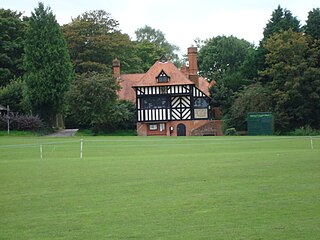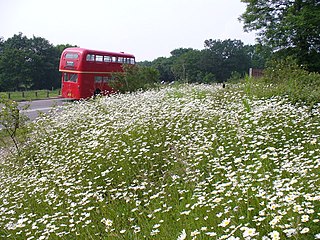
Hambledon is a rural scattered village in the Waverley borough of Surrey, situated south of Guildford. It is dominated by a buffer zone of fields and woodland, mostly south of the Greensand Ridge escarpment between Witley and Chiddingfold, having no dual carriageways or railways; however, it is bordered to the west by the Portsmouth Direct Line, and many of its small population are London commuters or retirees. Its main amenities are a church, a village pub, and the village shop and post office.

Aldworth is a village and mainly farmland civil parish in the English county of Berkshire, near the boundary with Oxfordshire.

Tilford is a village and civil parish centred at the point where the two branches of the River Wey merge in Surrey, England, 3 miles (4.8 km) south-east of Farnham. It has half of Charleshill, Elstead in its east, a steep northern outcrop of the Greensand Ridge at Crooksbury Hill on Crooksbury Common in the north and Farnham Common (woodland) Nature Reserve in the west, which has the Rural Life Living Museum. As the Greensand Ridge in its western section is in two parts, the Greensand Way has a connecting spur here to its main route running east–west to the south.

Ashbrittle is a village and civil parish in Somerset, England, situated nine miles west of Taunton and close to the River Tone and the route of the Grand Western Canal. The village has a population of 225.

Savernake Forest stands on a Cretaceous chalk plateau between Marlborough and Great Bedwyn in Wiltshire, England. Its area is approximately 4,500 acres.

Crowhurst is an isolated village situated five miles (8 km) north-west of Hastings in East Sussex. It has a parish council and is located within the Rother District Council.

Nonington, is a civil parish and village in east Kent, halfway between the historic city of Canterbury and the channel port town of Dover. The civil parish includes the hamlets of Easole Street, to which it is conjoined, Holt Street and Frogham. The 2021 census gives the population of the parish as 920. The area of the parish at 31 December 2020 is 2,510 acres (1,020 ha).

The Fortingall Yew is an ancient European yew in the churchyard of the village of Fortingall in Perthshire, Scotland. Considered one of the oldest trees in Britain, modern estimates place its age at an average of 5,000 years.

Tandridge is a village and civil parish in the Tandridge District, in the county of Surrey, England. Its nucleus is on a rise of the Greensand Ridge between Oxted and Godstone. It includes, towards its middle one named sub-locality (hamlet), Crowhurst Lane End. In 2011 the parish had a population of 663 and the district had a population of 82,998.

Newlands Corner is a 103-hectare (250-acre) nature reserve east of Guildford in Surrey, England. It is owned by the Albury Estate. It used to be managed by the Surrey Wildlife Trust under an access agreement between the estate and Surrey County Council, but is no longer managed by them.

Crowhurst is a village and civil parish in the Tandridge district of Surrey, England. The nearest town is Oxted, 3 miles (5 km) to the north. Rated two architectural categories higher than the medieval church is the Renaissance manor, Crowhurst Place, which is a Grade I listed building.

The Llangernyw Yew ( ) is an ancient yew in the village of Llangernyw, Conwy, Wales. The tree is fragmented and its core part has been lost, leaving several enormous offshoots. The girth of the tree at the ground level is 10.75 m (35.3 ft).

St Mary's Church in South Tidworth, Wiltshire, England, was built in 1878. It is recorded in the National Heritage List for England as a designated Grade I listed building, and is now a redundant church in the care of the Churches Conservation Trust.

The lime tree of Kaditz is a natural landmark situated in the churchyard of Emmaus Church in Kaditz, a district of Dresden in Saxony, Germany. The large-leaved lime tree is 20 metres (66 ft) high and is estimated to be between 500 and 1,000 years old. The girth of the trunk is about 10 metres (33 ft). In 1818 the tree was badly damaged by a huge fire in the village, which caused the trunk to split in two. It developed an abnormal growth to compensate for the damage done by the fire. This lime tree has often been written about and depicted, especially in Germany, and has also been used as a case study in dendrology, the science of trees and wooded plants. With its large girth it was ranked among the biggest lime trees in Germany even in the 19th century. The Kaditz Lime is also said to have served as a kind of pillory in the Middle Ages. The German Tree Archive includes it in its list of the most significant trees in the nation, in which the most important criterion is the girth of the trunk measured at a height of 1 metre.

The Wallace Yew is a tree in Elderslie, Renfrewshire in Scotland. It stands on grassland said to be near the home of medieval Scottish leader William Wallace. In legend, Wallace is said to have hidden in its branches to escape an English patrol. The tree is noted in parish records as early as the 18th century and still stands in 2019. In more recent times, it has been damaged by fire and storms and is now dying of a Ganoderma fungus infection. The Renfrewshire Council has taken cuttings of the tree to be grown as a replacement.

The Newland Oak was a veteran oak tree in Newland, Gloucestershire in England. Originally part of the ancient woodland of the Forest of Dean, it survived clearances that created the settlement of Newland and was afterwards pollarded for timber. Its large size was often remarked upon through the years and it was considered a rival to the Cowthorpe Oak as the largest oak tree in Great Britain. Much of the tree fell during heavy snow in 1955 but a single branch of the tree survived until 1970 when it was killed during an arson attack. A replacement tree grown from one of the Newland Oak's acorns had been planted in 1964.

The Ashbrittle Yew is an ancient yew tree located in the village of Ashbrittle, Somerset, in southwest England. The yew grows on a tumulus in the south-east end of the churchyard of St. John the Baptist. Yews are capable of living for several thousands of years; the Ashbrittle Yew itself is believed to be over 3,000 years old, but defining its precise age is difficult due to its hollow centre. The tree is formed of a hollow central trunk surrounded by six narrower boles. In 2015 its measured diameter was 39'11".

The Church of St Mary is an Anglican church in the village of Selborne, Hampshire, England. It is in the Diocese of Winchester. The building is Grade I listed; The church dates from about 1180, with modifications in the medieval period and restoration in the 19th century.



















